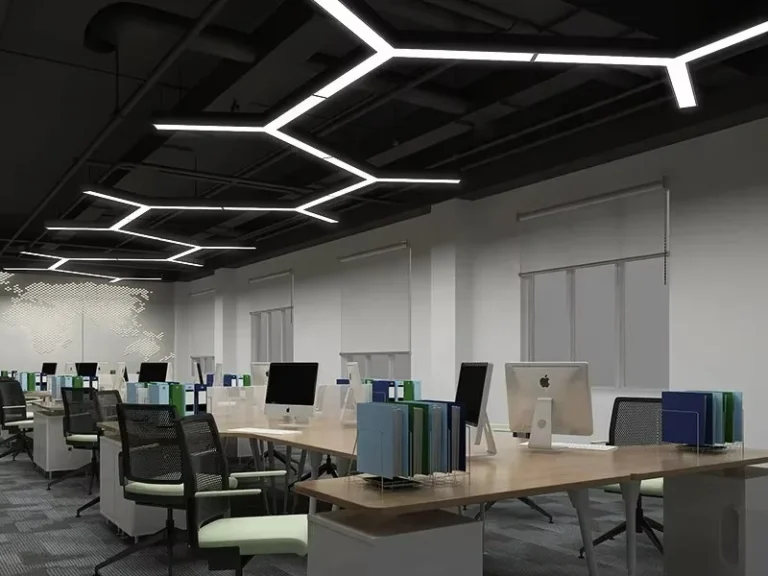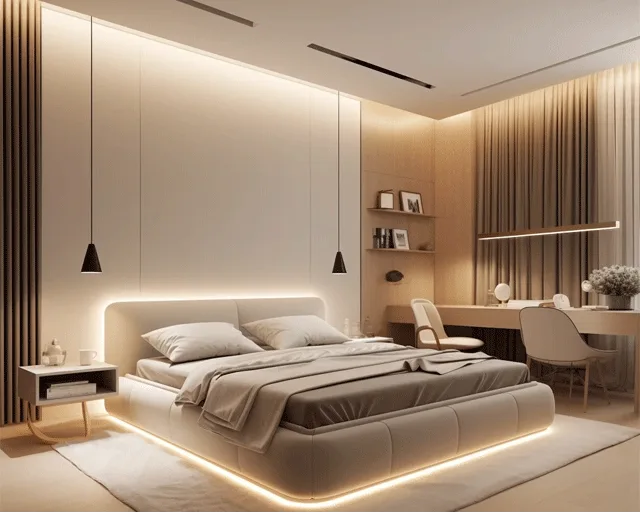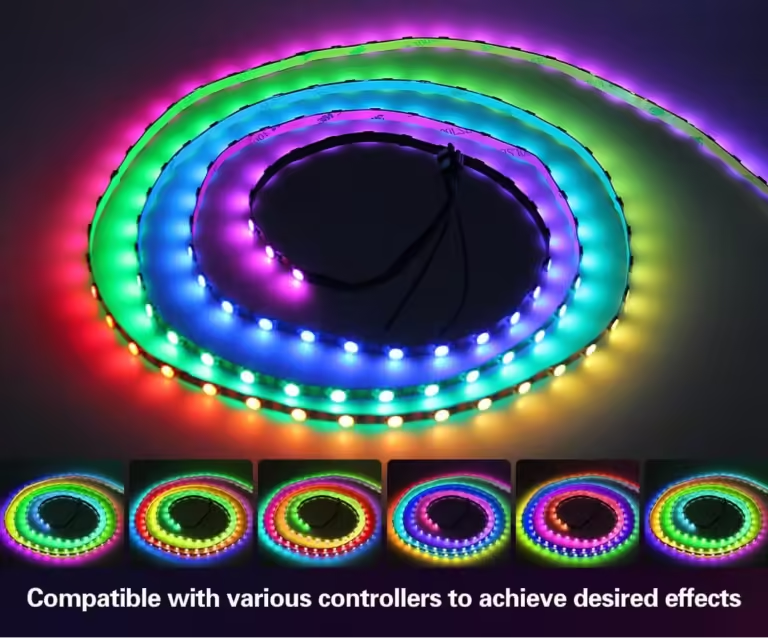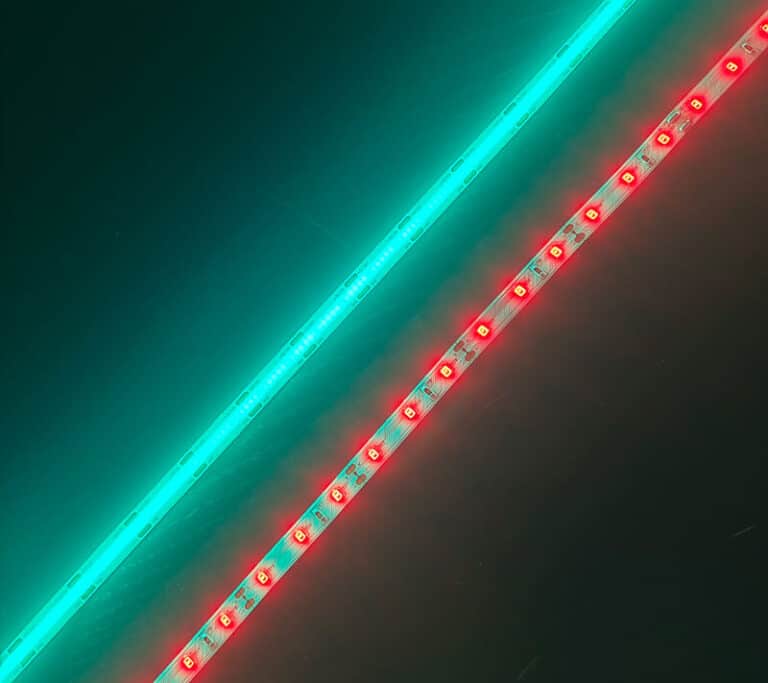Trong thiết kế ánh sáng thương mại và thiết kế nhà, đèn LED tuyến tính được phổ biến rộng rãi vì thiết kế đẹp và phân phối ánh sáng đồng đều. Tuy nhiên, việc bỏ qua việc đánh giá độ chói thống nhất (UGR) có thể dẫn đến mệt mỏi thị giác hoặc thậm chí là các mối nguy hiểm về an toàn. Chúng ta có thể đạt được trải nghiệm thoải mái khi “nhìn thấy ánh sáng mà không nhìn thấy nguồn sáng” bằng cách chọn ánh sáng thích hợp một cách khoa học.
Theo tiêu chuẩn quốc tế, các kịch bản khác nhau có yêu cầu rõ ràng đối với UGR. Văn phòng và phòng học thường yêu cầu UGR≤19, trong khi một số phòng triển lãm cao cấp và bệnh viện có yêu cầu cao hơn đối với UGR, yêu cầu UGR≤16. Do đó, UGR đã trở thành một yếu tố quan trọng không thể bỏ qua khi mua đèn LED tuyến tính.
Đèn tuyến tính LED có thể đạt được UGR dưới 19 không?
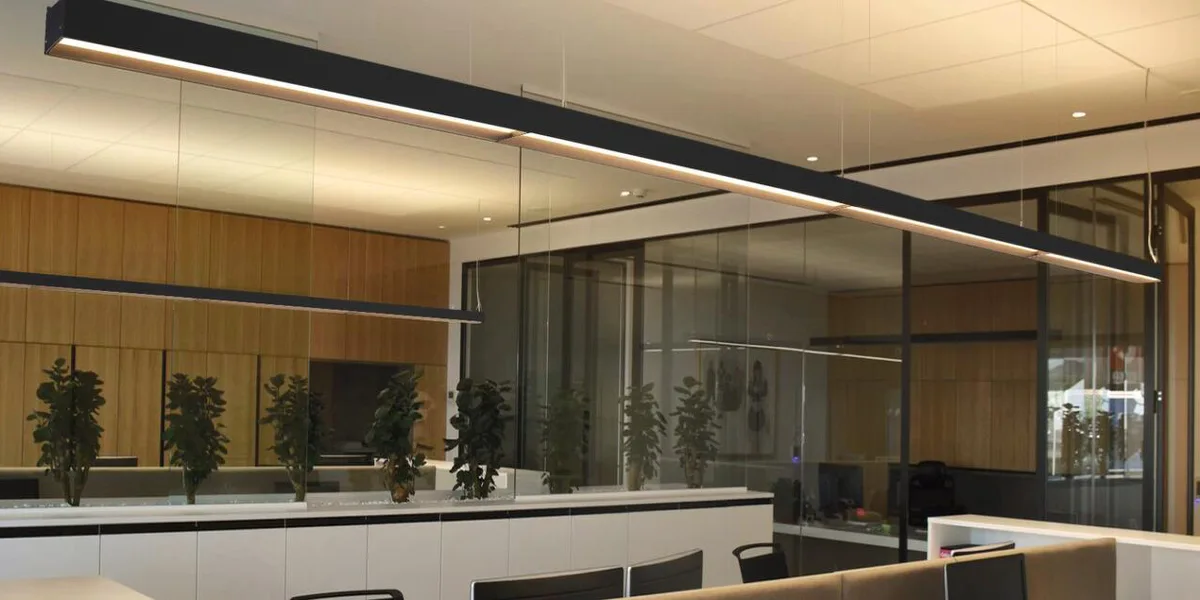
vâng, Đèn LED tuyến tính Có thể đạt được UGR dưới 19. Xếp hạng độ chói thống nhất (UGR) là một thông số quan trọng để đo hiệu ứng chói của ánh sáng. Môi trường ánh sáng lành mạnh như văn phòng yêu cầu UGR dưới 19 để đảm bảo sự thoải mái về thị giác. Ví dụ, đèn tuyến tính LED được thiết kế đặc biệt cho độ chói thấp có thể ổn định giá trị UGR dưới 19 thông qua các vật liệu quang học chống chói vi cấu trúc, tuân thủ các tiêu chuẩn chiếu sáng của tòa nhà.
Tuy nhiên, là nguồn chiếu sáng trực tiếp, đèn tuyến tính có thể gây rủi ro chói nếu thiết kế không đúng cách. Như được hiển thị trong dữ liệu đo lường thực tế bên dưới, giá trị UGR của chúng có thể đạt 22, vượt quá giới hạn trên CIE khuyến nghị, dẫn đến khó chịu như co đồng tử thường xuyên và đau đầu. Do đó, khi lựa chọn sản phẩm, nên ưu tiên những sản phẩm được dán nhãn rõ ràng là đáp ứng các yêu cầu của UGR.
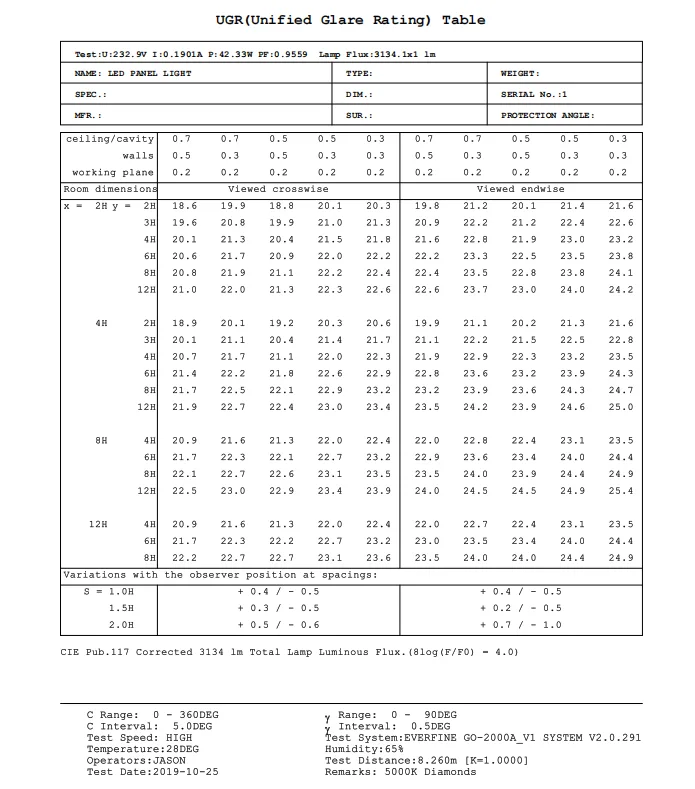
Tại sao đánh giá chói (UGR) của đèn tuyến tính nhỏ hơn 19?
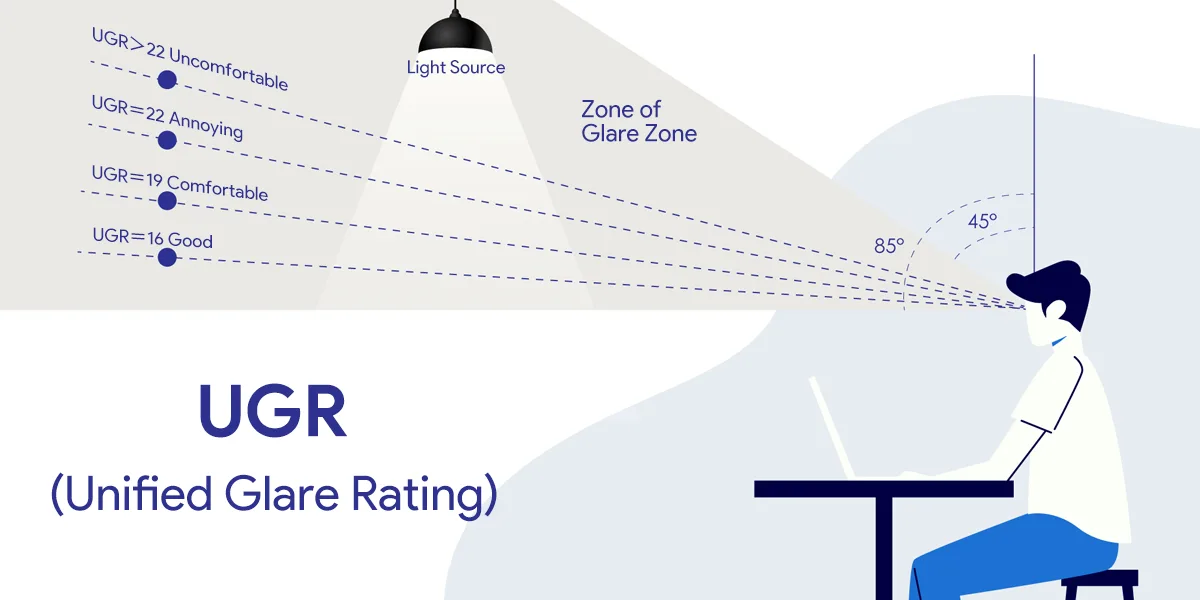
UGR (Uniform Glare Rating) là một tiêu chuẩn được quốc tế công nhận để đánh giá mức độ chói của ánh sáng tuyến tính trong nhà. Giá trị UGR càng thấp, độ chói càng yếu và sự thoải mái về thị giác càng cao. Giá trị UGR bị ảnh hưởng bởi nhiều yếu tố, bao gồm độ sáng nguồn sáng, vị trí và mức độ ánh sáng xung quanh.
Khi UGR vượt quá 19, học sinh thường xuyên điều chỉnh, dẫn đến mệt mỏi thị giác. Tiếp xúc lâu dài có thể gây tổn thương võng mạc, suy giảm thị lực và tăng nguy cơ đục thủy tinh thể. Chỉ riêng ở Trung Quốc, nơi hơn 60% của thanh thiếu niên bị cận thị, ô nhiễm chói đã được xác định là một trong những yếu tố góp phần chính.
Các tiêu chuẩn hiện tại yêu cầu các giá trị UGR trong môi trường ánh sáng lành mạnh phải dưới 19. Yêu cầu đối với UGR dưới 19 chủ yếu dựa trên các lý do sau:
- Đảm bảo sự thoải mái về thị giác: Giá trị UGR là 19 đánh dấu ngưỡng giữa độ chói vừa phải và đáng kể. Khi UGR ≥ 19, cảm giác ánh sáng chói tăng lên đáng kể, có khả năng gây mệt mỏi hoặc khó chịu thị giác. Tuy nhiên, khi UGR <19, độ chói vẫn nằm trong phạm vi chấp nhận được, phù hợp với môi trường như văn phòng và lớp học cần tập trung lâu dài.
- Thích ứng với yêu cầu nơi làm việc: Trong các khu vực văn phòng và các môi trường khác đòi hỏi các nhiệm vụ trực quan chính xác, UGR ≤ 19 cân bằng độ sáng và thoải mái, ngăn chặn ánh sáng chói không ảnh hưởng đến hiệu quả công việc. Ví dụ, tiêu chuẩn GB50034-2013 quy định rõ ràng rằng giới hạn trên UGR cho các khu vực văn phòng chung là 19, mô phỏng trải nghiệm thoải mái của môi trường ánh sáng tự nhiên.
- Phân biệt các tình huống ứng dụng: Thiết kế phân loại của các giá trị UGR xem xét mức độ dung sai của các vị trí khác nhau — UGR <19 phù hợp với môi trường có nhu cầu cao (chẳng hạn như văn phòng), trong khi UGR ≥ 19, gây chói mắt đáng chú ý, chỉ được khuyến nghị cho các cơ sở công nghiệp hoặc cửa hàng nơi yêu cầu về sự thoải mái thị giác thấp hơn.
Giá trị UGR được phân loại như thế nào?
Việc phân loại thoải mái của giá trị UGR (đánh giá đồng nhất) đã được xác định rõ ràng theo tiêu chuẩn quốc tế. Các ngưỡng thoải mái cụ thể và các tình huống áp dụng như sau:
Khi UGR <13, ánh sáng mềm mại, và mắt người khó có thể cảm nhận được ánh sáng chói. Điều này phù hợp cho những không gian có yêu cầu về sự thoải mái thị giác cực cao, như phòng trưng bày nghệ thuật và nhà ở cao cấp.
Khi UGR <16, nó nằm trong phạm vi thoải mái, với ánh sáng chói nhẹ không làm giảm các nhiệm vụ thị giác. Đây là tiêu chuẩn được khuyến nghị cho các lớp học, phòng đọc và các môi trường khác đòi hỏi làm việc chính xác. Ví dụ, đèn bảng bảo vệ mắt trong lớp học phải kiểm soát UGR ≤ 16 để bảo vệ tầm nhìn của thanh thiếu niên.
Giá trị UGR và phân loại trạng thái nhận thức của con người
| Phạm vi UGR | nhận thức của con người | Ví dụ kịch bản áp dụng |
| ugr <13 | Không có ánh sáng chói | Bệnh viện, phòng triển lãm cao cấp, các tổ chức đặc biệt |
| 13 ≤ UGR ≤ 16 | chói mắt | Bệnh viện, trung tâm hoạt động cao cấp |
| 16 ≤ ugr <19 | Lóa vừa phải, chấp nhận được nhưng có thể gây mệt mỏi | Văn phòng thông thường, phòng họp |
| 19 ≤ UGR <22 | ngưỡng cho sự khó chịu đáng chú ý | Nhà máy công nghiệp, kho |
| ugr ≥ 22 | chói mắt, gây đau đầu | Tránh thời gian lưu trú kéo dài của con người |
3 Tâm lý giữa thoải mái và khó chịu là UGR = 19, nhưng môi trường thị giác lành mạnh (chẳng hạn như không gian học tập) nên hướng tới UGR ≤ 16.
Tiêu chuẩn bắt buộc đối với các tình huống ứng dụng:
- Cơ sở giáo dục: Bắt buộc UGR ≤ 19 đối với lớp học; giải pháp chiếu sáng chất lượng cao nên được tối ưu hóa thành ≤ 16;
- Môi trường văn phòng: UGR> 19 gây co đồng tử thường xuyên dẫn đến mệt mỏi thị giác; điểm đủ điều kiện là ≤ 19;
- các trang web công nghiệp: UGR ≤ 22 được phép, nhưng phải sử dụng phụ kiện chống chói để giảm nguy cơ sức khỏe.
Khuyến nghị thực hành bảo vệ chói
| thước đo | Nguyên tắc kỹ thuật | Hiệu ứng giảm UGR |
| 2 Bảng khuếch tán vi lăng kính | Phân hủy các chùm sáng cường độ cao | giảm xuống ≤16 |
| Thiết kế chiếu sáng gián tiếp | Tránh vùng nhiễu 30 ° xung quanh mắt người | Giảm 30% |
| vật liệu có độ bóng thấp | Giảm ánh sáng phản chiếu môi trường | Tối ưu hóa 2-3 điểm |
Lưu ý: Các phép đo UGR yêu cầu một quang kế phân tán với thấu kính mắt cá; cần hiệu chuẩn nếu sai số vượt quá ± 10%.
Yêu cầu UGR cho chiếu sáng tuyến tính ở Châu Âu và Hoa Kỳ
Châu Âu và Hoa Kỳ có các tiêu chuẩn phân loại rõ ràng cho các yêu cầu UGR đối với ánh sáng tuyến tính LED. Quy định cụ thể và điểm thực hiện như sau.
Tiêu chuẩn chấm điểm UGR bắt buộc
Tiêu chuẩn cốt lõi của EU: Tất cả các ánh sáng tuyến tính trong nhà phải đáp ứng ngưỡng an toàn tối thiểu của UGR ≤ 19. vượt quá giá trị này sẽ dẫn đến việc không đạt được chứng nhận CE. Các địa điểm đặc biệt có các yêu cầu chặt chẽ hơn: Giáo dục / Khu vực văn phòng: UGR phải là ≤16, chẳng hạn như phòng học và văn phòng không gian mở; Phòng trưng bày nghệ thuật / Cơ sở y tế: UGR phải là ≤13, và các cấu trúc chống chói tổ ong phải được sử dụng.
Yêu cầu đặc biệt của Bắc MỹUL 1598 yêu cầu rõ ràng đèn LED chiếu sáng để kiểm soát các mối nguy hiểm quang học (không bao gồm dải bước sóng 4400-780 nm); Chứng nhận năng lượng Star yêu cầu thiết bị chiếu sáng thương mại phải có UGR ≤ 22 và phải chỉ ra mức ánh sáng xanh (mức miễn trừ RG0 được ưu tiên).
Thông số kỹ thuật chấp nhận đo lường UGR
| vật phẩm | Tiêu chuẩn EU | Yêu cầu bổ sung Bắc Mỹ |
| Chiều cao quan sát | Chỗ ngồi 1,2m / Đứng 1,5m | Tuân thủ tiêu chuẩn CIE 117-1995 |
| 2.1.2.2.2.2.1.2.1. | Đồng hồ đo độ sáng trường xem 143 ° | phải vượt qua hiệu chuẩn trắc quang UL |
| Hiệu chỉnh độ sáng nền | Loại bỏ nhiễu ánh sáng trực tiếp từ các thiết bị | Thêm mục phát hiện phản xạ phản chiếu |
So sánh tiêu chuẩn UGR giữa Châu Âu và Bắc Mỹ
| chỉ định | EU | Bắc Mỹ |
| sức mạnh thực thi | UGR> 19 Cấm lưu thông trên thị trường | Chứng nhận năng lượng Star |
| Trọng tâm kỹ thuật | Kiểm soát chói (UGR) làm trọng tâm cốt lõi | An toàn quang điện + Điều khiển kép hiệu quả năng lượng |
| nâng cấp hướng | Thực hiện UGR ≤ 16 vào năm 2025 | Tăng cường tiêu chuẩn an toàn cho phụ kiện pin nút (UL4200A) |
| Ngưỡng lõi | UGR ≤ 19 Ngưỡng bắt buộc (Yêu cầu cơ bản chứng nhận CE) | Không có ngưỡng bắt buộc cấp liên bang; Energy Star khuyến nghị ≤ 22 |
| yêu cầu kịch bản đặc biệt | Cơ sở giáo dục / y tế UGR ≤ 13 | Cho phép chiếu sáng công nghiệp UGR ≤ 25 (Phải đáp ứng tiêu chuẩn an toàn điện UL 1598) |
thuộc về phép pchỉ số nốt đôsự sưu tập
- EU: Bắt buộc sử dụng đồng hồ đo độ sáng hình ảnh trường 143 ° để loại bỏ nhiễu từ ánh sáng trực tiếp từ đèn chiếu sáng;
- bắc mỹ: Phải vượt qua thiết bị hiệu chuẩn trắc quang UL và thêm phát hiện phản xạ gương.
Tham khảo quan sát
- EU đồng nhất áp dụng chiều cao ngồi 1,2 m / chiều cao đứng 1,5 m cho tầm mắt;
- Bắc Mỹ phù hợp với các tiêu chuẩn của EU nhưng cho phép các nhà sản xuất xác định chiều cao thử nghiệm của riêng họ (tùy thuộc vào việc đăng ký).
Các nước châu Âu sẽ thực hiện các yêu cầu bắt buộc đối với trần nhà phản chiếu với phạm vi phủ sóng UGR≤16 (bao gồm cả không gian thương mại) bắt đầu từ năm 2025.: Độ sáng bề mặt đèn ≤2000 cd/m²; chụp đèn mờ có độ phản xạ <60%.
Thiết bị chiếu sáng không dây phải tuân thủ bổ sung: Chứng nhận tần số vô tuyến FCC (47 CFR phần 15), và các phụ kiện pin di động nút phải tuân theo UL 4200A 3.
Cảnh báo xu hướng: Các quy định mới của EU vào năm 2025 sẽ kết hợp an toàn quang học (RG0) vào hệ thống đánh giá UGR và Bắc Mỹ sẽ đồng thời nâng cấp các tiêu chuẩn kiểm soát ánh sáng xanh UL 153.
Làm thế nào để đo giá trị UGR của đèn tuyến tính LED?
Giá trị UGR của Đèn LED tuyến tính thường được đo bằng máy đo độ quang học, có thể lấy dữ liệu trắc quang và mô phỏng các phép tính bằng phần mềm tiêu chuẩn. Sau đây là các thủ tục kiểm tra cụ thể và các điểm chính:
Cố định đèn chiếu sáng tuyến tính vào giá treo quay của máy đo độ quay của máy đo độ sáng. Bằng cách xoay vật cố định hoặc gương phản xạ, nắm bắt dữ liệu phân bố cường độ ánh sáng trên không gian 360 °, tạo ra tệp trắc quang định dạng IES chứa các thông số như thông lượng phát sáng và phân bố cường độ ánh sáng.
Đèn tuyến tính dài thường thuộc loại đèn đối xứng hai trục (ví dụ: đèn bảng dài), yêu cầu kiểm tra các đường cong phân phối ánh sáng cho hai mặt phẳng đối xứng: mặt phẳng dọc (C0-C180) và mặt phẳng ngang (C90-C270).
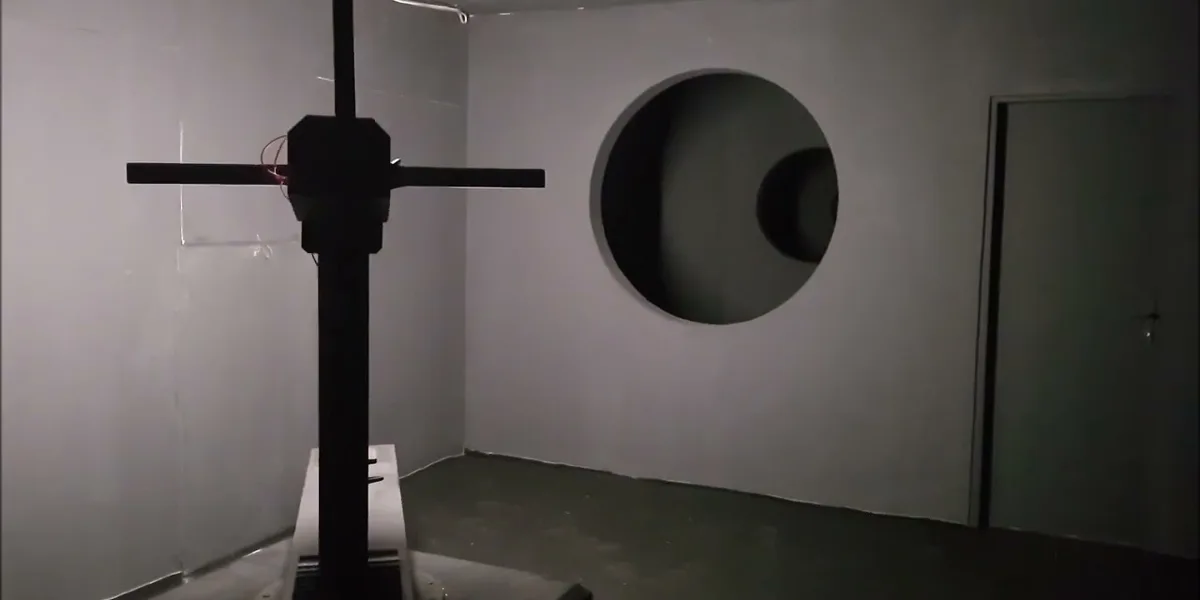
Xác thực dữ liệu
Đảm bảo rằng tệp IES chứa thông tin phân phối ánh sáng đầy đủ (chẳng hạn như góc cạnh nửa đỉnh và góc trải chùm tia), và góc rắn sáng ω của đèn chiếu sáng nằm trong khoảng từ 0,0003 đến 0,1 SR để đáp ứng các điều kiện tính toán UGR.
Nhập tệp IES vào phần mềm mô phỏng
Khi tải tệp IES của một vật cố định ánh sáng tuyến tính vào phần mềm chuyên nghiệp như Dialux, hãy xác nhận rằng tệp đó ở định dạng đối xứng hoàn toàn hoặc đối xứng hai trục (các thiết bị không đối xứng không thể tạo bảng UGR). Nếu tệp IES không tự động điều chỉnh, hãy điều chỉnh tính đối xứng bằng công cụ sửa chữa.
Thiết lập môi trường mô phỏng tiêu chuẩn
Theo tiêu chuẩn CIE 117-1995, xây dựng một phòng ảo và xác định các thông số chính:
- Kích thước không gian: Đặt chiều dài và chiều rộng động theo x = 2h, 4h, 8h, 12h (trong đó h là chiều cao từ mắt của người quan sát đến chiều cao lắp đặt đèn chiếu sáng);
- sự phản chiếu: Nhập hệ số phản xạ thực tế cho trần và tường (giá trị mặc định: trần 0,7, tường 0,5);
- Vị trí người quan sát: Duy trì một đường ngắm ngang, với khoảng cách mặc định từ điểm trung tâm của đèn.
- Tạo bảng UGR và hiệu chỉnh: Phần mềm xuất ra “Bảng đánh giá độ sáng UGR tham chiếu” (Bảng UGR chưa được hiệu chỉnh), biểu thị các giá trị lý thuyết cho nguồn sáng trần ở thông lượng phát quang 1000 lm.
- Công thức sửa UGR thực tế: UGR thực tế = giá trị bảng + 10 × log (thông lượng ánh sáng thực tế của đèn điện / 1000). Ví dụ, khi thông lượng ánh sáng của đèn là 2000 lm, thêm 3 vào giá trị bảng (10 × log₂ ≈ 3).
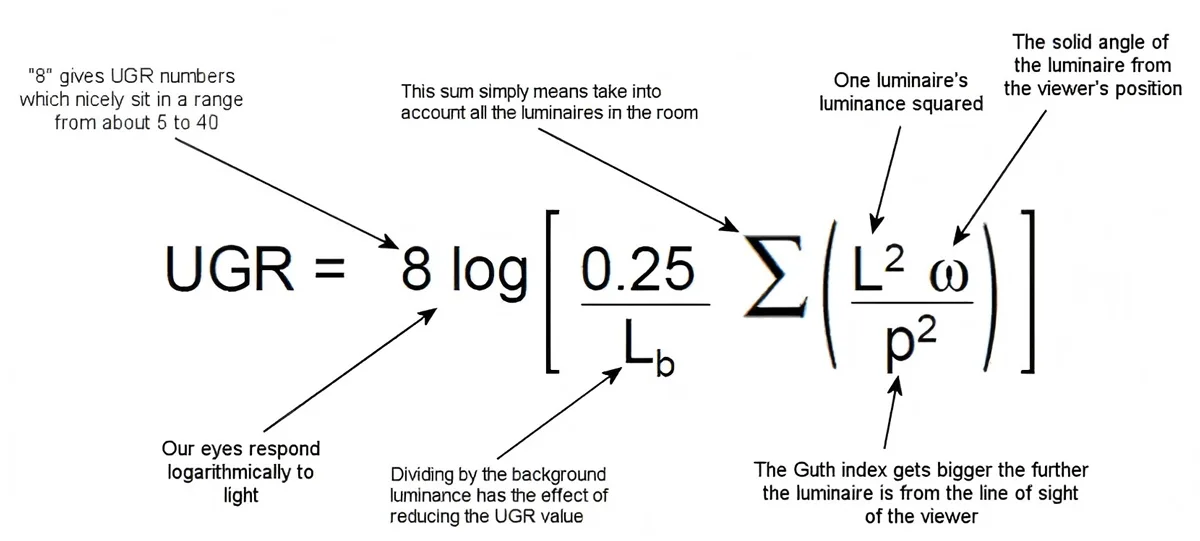
- Hạn chế ứng dụng: UGR chỉ áp dụng cho môi trường trong nhà và đèn chiếu sáng đối xứng song phương; đèn chiếu sáng tuyến tính có thiết kế phân cực (như đèn chiếu tường không đối xứng) không thể được đánh giá trực tiếp bằng phương pháp này.
- Sự khác biệt giữa UGR đo được và kết quả mô phỏng: Kết quả mô phỏng là các giá trị tham chiếu môi trường tiêu chuẩn; việc lắp đặt thực tế bị ảnh hưởng bởi kích thước không gian, vật liệu phản chiếu, v.v.
Làm thế nào để giảm hiệu quả giá trị UGR của đèn tuyến tính?
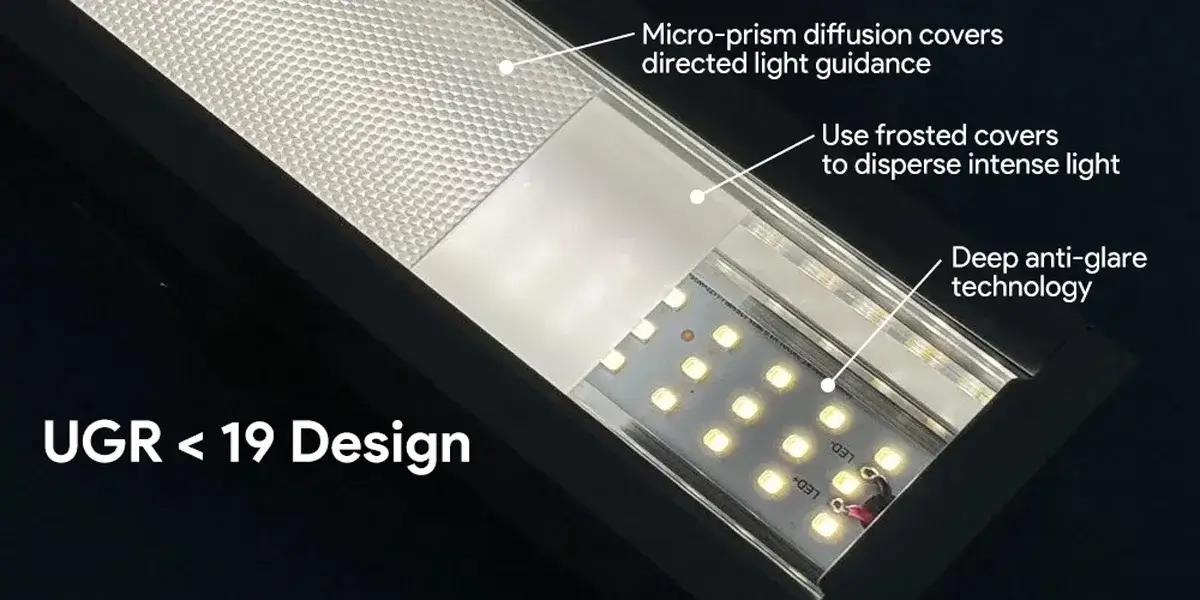
- Tối ưu hóa cấu trúc quang học: Áp dụng thiết kế góc chói và công nghệ chống chói sâu, với góc chói ≥25 cm để chặn ánh sáng trực tiếp chiếu vào mắt. Đối với các thiết lập công nghiệp, nên lắp đặt đèn ở độ cao ≥3,5 m và kết hợp chúng với các tấm phản xạ để giảm độ chói.
- làm láng số kim hiệusự tái cấu trúc số kim hiệumáy công trình: Sử dụng lưới chống chói để làm suy yếu phản xạ đi lạc, đạt được mức giảm 30% trong UGR (đặc biệt thích hợp cho môi trường có độ phản xạ cao); Ngoài ra, sử dụng chụp đèn mờ / mờ để phân tán ánh sáng mạnh, đảm bảo khuếch tán ánh sáng đồng đều, với độ phản xạ bề mặt <60%;
- phần triệu cực nhỏpống có hàm bảo dưỡng nốt thứ hai trongsự phun lửa pkho chứa bàn ghế: Hướng dẫn ánh sáng, giảm UGR từ 21 xuống 14.
- cài đặt và lớnkhông nhận nốt đôđiểm kết thúc- Ưu tiên lắp đặt âm tường để tránh đèn bị lộ; đèn tuyến tính phải được nhúng vào trần hoặc tường (chiều sâu nhúng ≥2cm); khi lắp đặt kính phân cực, phải sử dụng các thấu kính phân cực để hướng ánh sáng về phía bề mặt làm việc. Đèn không được đặt trong phạm vi tầm mắt 30 ° (chiều cao ≥1,8 m so với mặt đất an toàn hơn); trần gương phải được kết hợp với chụp đèn mờ để ngăn chặn phản xạ thứ cấp.
- điều khiển vật liệu tường: Sử dụng sơn mờ (Reflectance <60%), tránh các vật liệu có độ phản xạ cao như tường hoặc gạch ốp; lắp các khe ánh sáng phản chiếu cong để chuyển đổi ánh sáng trực tiếp thành ánh sáng khuếch tán (Đo UGR giảm từ 21 xuống 13).
- rg0-lớnchiều nốt simàu sắc lớntrạng thái cao nốt đôđiểm kết thúc: Sử dụng nguồn sáng toàn phổ để giảm kích thích quang học;
- làm đau đớn nốt thứ hai trongvật sắp cưới SYestm: Giảm độ tương phản ở các vùng có độ sáng cao (phải được chứng nhận FCC / CE).
- lời ghi chép: Bóng đèn LED trong suốt là nguồn sáng lộ ra và có thể gây chói mắt; tránh bố trí dày đặc, với khoảng cách đèn ≥ 1,5 lần chiều rộng của đèn chiếu sáng; các bề mặt phản chiếu như đồ nội thất được nhân đôi, bàn làm việc và màn hình nên được bù đắp từ góc chiếu của đèn.
- Tác dụng vsự sanh hóa lể: Đo giá trị UGR đã hiệu chỉnh bằng cách sử dụng đồng hồ đo độ sáng hình ảnh 143 ° để đảm bảo ≤19 (văn phòng) hoặc ≤13 (y tế / giáo dục).
Ngoài ra, để đáp ứng UGR ≤19, các dự án chiếu sáng phải sử dụng điều khiển công nghệ ba:
- thuộc về phép nốt thứ hai trongký tên vào bản nhạc: Sử dụng các tấm khuếch tán ánh sáng có cấu trúc vi mô để giảm độ sáng bề mặt;
- mưu kế: Tránh vùng giao thoa mắt người (trong trường nhìn hướng lên 30 °);
- thuộc về vật chất Ssự lựa chọn: Sử dụng vật liệu có độ bóng thấp để giảm độ chói phản chiếu. Ví dụ, ánh sáng trong lớp học được yêu cầu phải có UGR ≤ 19 (tiêu chuẩn quốc gia GB7793-2010), trong khi các thiết bị cao cấp (chẳng hạn như đèn đường) được tối ưu hóa hơn nữa đến UGR ≤ 16.
- Tối ưu hóa quang học: Lắp đặt tấm khuếch tán vi lăng kính: UGR có thể giảm từ 21 xuống 14; Sử dụng thấu kính phân cực: Cài đặt công nghiệp cho phép UGR ≤ 25, nhưng phải ghép với các bức tường có độ phản xạ ≤ 60%.
- Cài đặt Điều cấm Nghiêm cấm đặt đèn trần trong tầm nhìn 30° của mắt người; độ cao 1,8m so với mặt đất an toàn hơn; trong các thiết lập trần gương, phải sử dụng chụp đèn mờ.
Đèn LED LinearLited LineLine 4 ưu điểm cốt lõi
Hiệu suất quang học vượt trội: Với thiết kế giảm chói với UGR <19, ánh sáng được khuếch tán đều qua bảng điều khiển khuếch tán lăng trụ, được bổ sung bởi hệ thống thấu kính quang học có độ chính xác cao giúp kiểm soát hiệu quả độ sắc nét của ranh giới điểm sáng, đạt được các tiêu chuẩn triệt tiêu chói cấp bảo tàng.
Thiết kế kết cấu công nghiệp: Được chế tạo với cấu hình hợp kim nhôm cấp không gian và công nghệ phủ nano, nó tự hào có xếp hạng bảo vệ IP66, có khả năng chịu được môi trường khắc nghiệt từ -30 ° C đến 60 ° C. Cấu trúc lắp ráp mô-đun sáng tạo của nó hỗ trợ điều chỉnh đa chiều từ 0 ° đến 90 °, phù hợp với việc lắp đặt trong không gian cong hoặc không đều.
làm đau đớn chữ thứ năm tronghệ thống chung TÔIsự hóa trị: Trình điều khiển giao thức kép DALI / PWM tích hợp, tương thích với các hệ thống điều khiển thông minh chính thống. Công nghệ tản nhiệt Graphene đạt được trên 93% hiệu quả năng lượng chuyển đổi, kết hợp với tuổi thọ trên 50.000 giờ, tiết kiệm năng lượng hơn 40% so với các thiết bị chiếu sáng truyền thống.
khác nhau vgấp: Sản phẩm được chứng nhận bởi CE và RoHS, bảo hành 5 năm. Hệ thống dịch vụ tùy chỉnh có thể đáp ứng các yêu cầu về nhiệt độ màu đặc biệt (có thể điều chỉnh từ 2700K đến 6500K) và chỉ số hiển thị màu (RA ≥ 95) cho không gian thương mại, phòng trưng bày nghệ thuật và các kịch bản khác.
Với hiệu suất quang học vượt trội, cấu trúc cấp công nghiệp bền bỉ, khả năng tương thích điều khiển thông minh và các dịch vụ tùy biến cao, Signiteled Đèn LED tuyến tính đã trở thành sự lựa chọn lý tưởng cho ánh sáng kiến trúc hiện đại và không gian thương mại cao cấp. Cho dù bạn đang thực hiện một dự án xây dựng mới hay nâng cấp ánh sáng, Signitel có thể cung cấp cho bạn các giải pháp chiếu sáng hiệu quả hơn, thông minh hơn và có định hướng thiết kế hơn.

